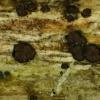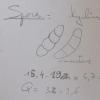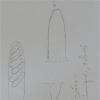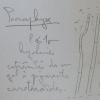
18-12-2025 21:17
Pol DebaenstThe identification took me to Byssonectria deformi

15-12-2025 07:09
 Danny Newman
Danny Newman
indet. Rutstroemiaceae sp. on unk. fallen leavesMc

19-12-2025 10:10
Patrice TANCHAUDBonjour, récolte réalisée en milieu dunaire, a

18-12-2025 17:23
 Bruno Coué
Bruno Coué
Bonjour,je serais heureux d'avoir votre avis sur c

18-12-2025 18:07
Margot en Geert VullingsThese plumes were found on rotten wood.They strong

17-12-2025 18:35
 Michel Hairaud
Michel Hairaud
Bonjour à tous/Hi to everyone I am passing along

15-12-2025 15:48
 Danny Newman
Danny Newman
Melanospora cf. lagenaria on old, rotting, fallen

15-12-2025 15:54
 Johan Boonefaes
Johan Boonefaes
Unknown anamorph found on the ground in coastal sa

15-12-2025 21:11
 Hardware Tony
Hardware Tony
Small clavate hairs, negative croziers and IKI bb
 Hi.
Hi.Macro : apo with a red to dark red hymenium, excipulum dark. Same appearance than Rhytidisteron hysterinum when dry.
Found on dead branches of Cytisus oromediterraneus.
Micro : spores hyalines, 4-celled, 15,4-19x4,7-5,6 um Q=3,2-3,6
Ascus with bisseriate spores, IKI-, croziers+, 103-123x10,6-10,8 um
Paraphyses filiform, hyaline, without pigmentation, apex sometimes stuck in a red carotenoid gel. lI haven't be able to make a cross section because apo are too gelatinous.
See attached pictures.
So, I think this is clearly a Durella specie.
On Zotto's CD, I found a decription of Durella "aurantionigra" that fits very well with my specie. Is-it still a workname or has-it been described ?
What do you think about all of that ?
Yannick
?

You did no figure the spore contents, though I fear they are not constant in this group. But they are always there, lipid content around 4.
The anamorph could help in solving the problem if there are several species or not. The genus Plasia was found by Sherwood as anamorph, and I have data on associated sporodochia with different ?conidia, in the case you find something similar to the apothecia but with conidia inside.
Zotto

No, I haven't seen any oil drop inside these spores. I have checked it now.
Sorry, I don't understand your first sentence : "I am not sure if there is only one variable species D. atrocyaneam?". What do you meen ? D. aurantionigra/atrocyaneam ?
I'm not able to cultivate the anamorph. So, do you suggest to name it as Xylogramma sp. ?
Amitiés.
Yannick

OK, no I understand. I have looked at your CD... So you prefer Xylogramma atrocyanea ? But, has this specie a red hymenium ? On your pictures, all is dark. Mine are red to dark red.
Yannick

If your material is alive, you should see the oil drops in the spores. Ifr it is dead you need to mount in KOH, then you will see them. If there aren't any, your collection is perhaps something else.
Zotto

Amitiés.
Yannick

Zotto

i wanna ask you about the embedded paraphyses in D. atrocyanea? is it a character?
thnkss

In X. atrocyanea the olivaceous exudate dissolves in KOH very similar as in Claussenomyces. In Durella no such dissolutiun is observable. So I considered the possibility of a relation to that genus.
Xylogramma has a protruding, +/- toothed margin, possibly the young apothecia are closed and break into teeth.
Zotto





